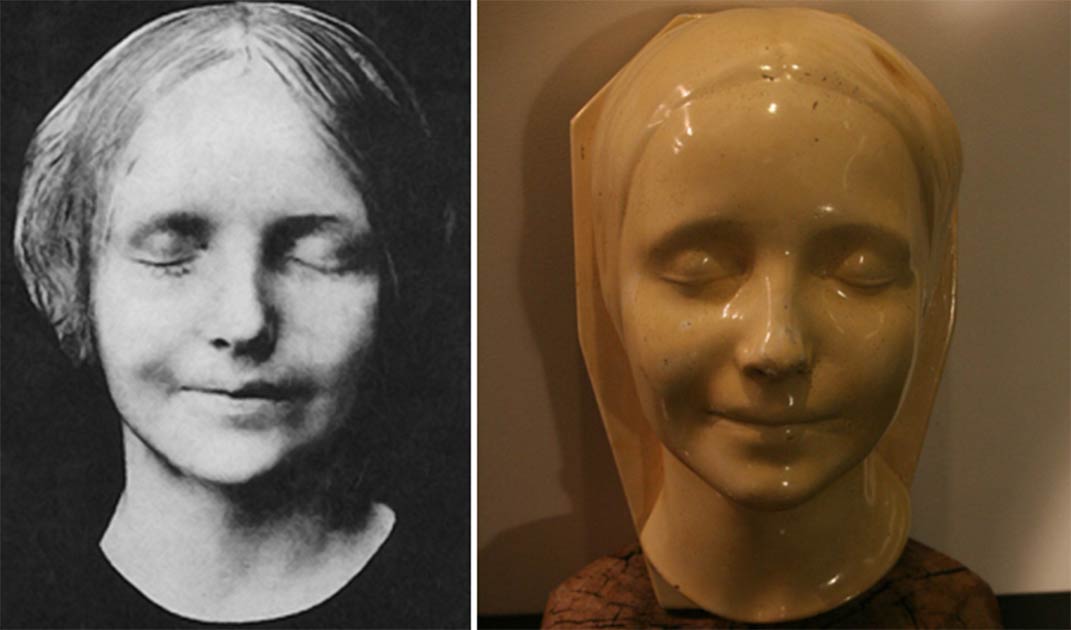3 Pics: The most kissed face in the world – The story of the pretty drowned French girl
[This is a strange story, but maybe in a sense something good too. Who was this lovely young white girl who died as she did. What I discovered, which is interesting science is that because there are few experiments done on the dying, that with rats, scientists discovered that when they are dying, right near the end, the body releases a chemical that gives a sense of euphoria. This may explain near death experiences. I have read many times before, that drowning is apparently quite pleasant. This explains the lovely relaxed look on this poor lovely girl's face. I like the idea that her face is used for dummies used for first aid practise. Jan]
This is what she looked like when they got her out of the river. And they made a death mask of her:

In the late 1880s, the body of an unidentified young woman was pulled out of the Seine at the Quai du la Louvre, not far from the museum of the same name. While the Louvre houses the Mona Lisa, the river offered up an enigmatic smile of its own, and the woman—only the latest in a string of presumed suicides—became a beauty icon in her own right.
Dubbed l’Inconnue de la Seine (the Unknown Woman of the Seine), her body quickly became the star attraction of the already popular public morgues in Paris. People turned out in droves to see her, moved not only by her young age—she was thought to be about sixteen—but by the curiously peaceful expression on her face. She was beautiful, yes, but what struck them was that she appeared to be happy.
A wax plaster death mask was cast so early, it faithfully reproduced her wet, matted hair and the droplets of water in her eyelashes. Her death was a mystery that remains unsolved to this day, and she was never identified. It has been argued that no one who had drowned—let alone a suicide—could have died with such a relaxed, almost joyful look on their face, leading many to speculate that her cause of death was not drowning at all.
Finding a young woman in the river was a heartbreakingly common occurrence. Bodies of sex workers were pulled out of the Seine almost daily, all of them assumed suicides unless there was clear evidence to the contrary. Because no injuries could be found on her body, l’Inconnue was presumed to be another sex worker who had tragically taken her own life.
The mask of l’Inconnue became an obsession of Bohemian Paris, inspiring art and literature for decades after her death. Albert Camus pointed out the parallel to the Mona Lisa, and women were all too happy to emulate her. While her life was presumably difficult and tragically short, she was a muse in death, and bizarrely, an erotic ideal. Copies of the death mask were mass produced and sold as spectacularly morbid household decorations through the early twentieth century, and there is a workshop that still makes masks from the same mold to this day.
Even if you haven’t heard of her before today, chances are, you’ve kissed her yourself. In the 1950s, Norwegian company Laerdal Medical gave l’Inconnue a new life that would become her most enduring legacy. When they were developing the first CPR doll, they decide they needed a non-threatening face people wouldn’t mind kissing. L’Inconnue was perfect—beautiful, widely known, and there was already a mold of her face. As Resusci Anne (CPR Annie), the face of l’Inconnue reached an even wider audience as a staple of CPR courses around the world. Though most don’t know about the macabre origins of the doll, it’s a fitting legacy for the Unknown Woman of the Seine that in death, she saves others from drowning.
Source: https://dirtysexyhistory.com/tag/linconnue-de-la-seine/


